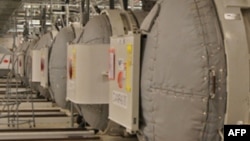Iran has installed half the advanced uranium-enriching machines it said earlier this month it would quickly add to its Fordow site dug into a mountain but has not yet brought them online, the U.N. nuclear watchdog said in a report seen by Reuters.
Iran informed the International Atomic Energy Agency two weeks ago that it would rapidly expand its enrichment capacity at Fordow by adding eight cascades, or clusters, of IR-6 centrifuges at Fordow within three to four weeks.
Within two days the IAEA had verified that two of the cascades had been installed. In a confidential report to member states on Friday the agency said that number had now doubled.
"The Agency has verified that Iran has installed four of the aforementioned eight IR-6 cascades in Unit 1 at FFEP [Fordow Fuel Enrichment Plant]," the report said, adding that the verification happened on Sunday.
"Iran has not specified to the Agency when it would start feeding any of the cascades in Unit 1 with UF6 or the planned enrichment level," it added, referring to uranium hexafluoride gas, the feedstock for centrifuges.
Diplomats say the addition of the IR-6 machines was a response to a resolution against Iran by the IAEA's 35-nation Board of Governors on June 5 calling on Tehran to step up cooperation with the watchdog and reverse its recent barring of inspectors. Iran tends to bristle at such resolutions.
The United States announced new sanctions targeting Iran's oil trade on Thursday, saying it was acting in response to "steps [by Iran] to further expand its nuclear program in ways that have no credible peaceful purpose."
Iran is enriching uranium to up to 60% purity, close to the roughly 90% of weapons grade, at two sites: Fordow and an above-ground pilot plant at Natanz. It has enough material enriched to up to 60%, if enriched further, for three nuclear weapons, according to an IAEA yardstick.
At Fordow, it is currently using the two only operating cascades of IR-6 centrifuges there to enrich to 60% from 20%.
Iran also informed the IAEA this month that it would bring online more of the dozens of advanced centrifuges it has installed at its largest enrichment site, the underground Fuel Enrichment Plant, or FEP, at Natanz.
The report said Iran plans to feed UF6 into 15 cascades of IR-2m and IR-4 machines already installed but not yet enriching. The last quarterly IAEA report in May put the number of those machines installed but not operating at 21.
Iran has now carried out passivation, a process that involves feeding UF6 into centrifuges in preparation for enrichment without accumulating enriched uranium, on six of those cascades, Friday's report said.
"Iran has started feeding, for passivation purposes, 4 natural UF 6 into an additional three IR-2m cascades and three IR-4 cascades for the first time," it said.
Iran had also begun installing one of the 18 extra IR-2m cascades it said this month it would set up at the FEP, the report added.









